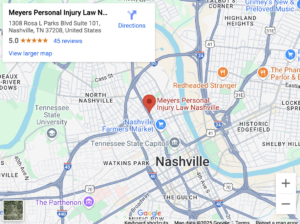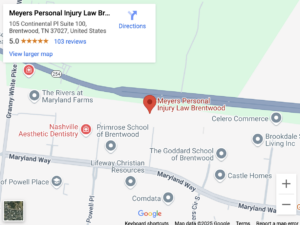Chad Meyers | August 23, 2024 | Personal Injury

Navigating the complexities of personal injury law can be daunting, especially when determining the value of a broken bone case in Tennessee. Victims often face not just physical pain but significant financial burdens as well. Having a clear understanding of what factors influence the compensation amount is crucial.
In Tennessee, the worth of a broken bone case typically hinges on several key factors, including medical expenses, lost wages, and the degree of pain and suffering. Each of these elements contributes to the final settlement or court award. Additionally, the circumstances of the injury and the liable party’s insurance coverage play significant roles. The personal injury services of Meyers Personal Injury Law can help you if you need help with your broken bone case.
Understanding Personal Injury Law in Tennessee
The Basis of Personal Injury Claims
Personal injury claims in Tennessee arise from instances where an individual’s actions harm another person. These claims often involve accidents, such as vehicular collisions, slips and falls, or medical neglect.
Victims must prove that the defendant acted negligently and that this negligence directly caused their injuries. This process requires demonstrating that a duty of care existed, the duty was breached, and the breach led to measurable harm.
Evidence like medical records, witness testimonies, and expert opinions are crucial in supporting these claims. A thorough review of each element is essential, as Tennessee follows specific standards in evaluating cases.
Role of Comparative Fault in Tennessee
Tennessee adheres to the principle of modified comparative fault, which can significantly impact personal injury cases. Under this rule, if the plaintiff is found to be partially at fault, their compensation is reduced by their percentage of fault.
If a plaintiff is more than 50% at fault, they cannot recover any damages. For instance, if someone is deemed 20% responsible for their injuries and incurs $10,000 in damages, they would only receive $8,000.
The precise determination of fault percentages often involves detailed scrutiny by insurance companies, legal representatives, and sometimes a court. Understanding this principle is critical for anyone involved in personal injury litigation in Nashville, Tennessee.
Factors Influencing the Value of a Broken Bone Case
Several factors impact the value of a broken bone case in Tennessee, such as the injury’s severity, medical costs, lost income, pain, and how it affects daily life and quality of living.
Severity of the Injury
The severity of the broken bone significantly affects case value. Simple fractures typically result in lower compensation compared to compound fractures, which may involve multiple bones and additional complications. Serious fractures might lead to permanent limitations or require long-term medical care, substantially increasing case worth. In some instances, if the broken bone leads to chronic pain or disability, compensation can be higher to account for these lasting impacts.
Medical Costs and Future Treatment
Medical costs are a critical factor in calculating damages. These expenses include hospital bills, surgeries, prescriptions, and rehabilitation. Future medical treatments such as additional surgeries or ongoing physical therapy are also considered. Long-term costs can add substantial value to a case, particularly if the injury requires extensive future care. Documentation of all current and anticipated expenses is essential for accurately determining the compensation amount.
Income Loss and Impaired Earning Capacity
Loss of income during recovery is a key factor. If the injured person cannot work while healing, they can claim lost wages. For injuries that affect future earning capacity, the claimant can seek compensation for impaired earning potential. This includes current and future lost income, especially if the injury leads to reduced work hours or prevents the injured party from continuing their previous employment.
Pain and Suffering
Compensation for pain and suffering addresses the non-economic impacts of the injury. This aspect includes physical pain, emotional distress, and mental anguish caused by the injury. The amount awarded varies and typically depends on the injury’s severity and the extent of its impact on the claimant’s life. Testimonies from medical professionals, along with personal accounts, often help quantify this damage.
Impact on Lifestyle and Quality of Life
The injury’s impact on the claimant’s daily activities and overall quality of life is also considered. If the broken bone limits the ability to enjoy hobbies, perform daily tasks, or participate in personal relationships, the case value can increase. Documenting lifestyle changes and disruptions helps build a stronger claim for compensation. Long-term effects that diminish life quality can lead to higher settlements or awards.
Calculating Compensation for a Broken Bone
Economic Damages
Economic damages cover direct financial costs. These typically include medical expenses, such as hospital bills, surgery costs, and physical therapy sessions.
Lost wages are also a significant part of economic damages. If the injury causes the individual to miss work, the lost income can be compensated.
Future medical costs may be considered if the injury requires long-term treatment. For instance, continued physical therapy or future surgeries can add to the total compensation amount.
Property damage might be relevant if personal belongings were damaged during the incident leading to the broken bone. For instance, in a car accident, the cost to repair or replace a vehicle could be included.
Non-Economic Damages
Non-economic damages address intangible effects. Pain and suffering are major components, recognizing the physical pain and emotional stress resulting from the injury.
Loss of enjoyment covers the inability to participate in activities that were once enjoyed. If the broken bone prevents someone from hobbies or daily routines, this can be factored in.
Emotional distress compensation can be awarded for mental health impacts. Anxiety, depression, and other psychological effects tied to the injury are considered here.
Physical impairment compensation acknowledges long-term or permanent disabilities resulting from the broken bone. This addresses the reduced ability to perform everyday tasks.
Legal Process and Representation
In Tennessee, filing a broken bone injury claim begins with documenting the injury and collecting medical records. This evidence is crucial for building a strong case.
Legal representation is highly recommended. An experienced attorney from Meyers Personal Injury Law can help navigate the complexities of personal injury law, ensuring that the victim’s rights are protected.
Attorneys often work on a contingency fee basis, meaning they only get paid if the case is won. This arrangement can alleviate financial stress for the injured party.
The legal process involves several steps, including:
- Filing a claim with the insurance company
- Negotiations for a settlement
- Potential litigation if a settlement cannot be reached
During negotiations, an attorney can advocate for fair compensation, considering medical expenses, lost wages, and pain and suffering.
If the case goes to court, the attorney represents the injured party’s interests, presenting evidence and arguments to support the claim. The court process might include hearings, depositions, and possibly a trial. Contact Meyers Personal Injury Law for help with your broken bone case.
Contact Our Nashville Personal Injury Law Firm Today at Meyers Personal Injury Law
If you were injured in an accident in Nashville or Brentwood and need legal help, contact our Nashville personal injury lawyers at Meyers Personal Injury Law to schedule a free case review today.
Meyers Personal Injury Law Nashville
1308 Rosa L Parks Blvd Suite 101,
Nashville, TN 37208
(615) 258-9000

Meyers Personal Injury Law Brentwood
105 Continental Pl Suite 100,
Brentwood, TN 37027
(615) 258-9000



